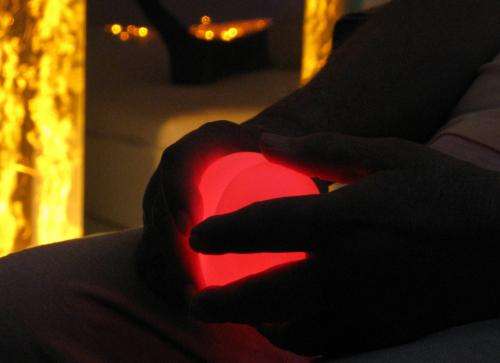New guide highlights ways to boost use of multi-sensory environments in dementia care

A new guide developed by two British academics has shed fresh light on the positive impact multi-sensory environments can have when caring for people with dementia.
The publication, How to make a sensory room for people living with dementia, has been unveiled as part of the Inside Out Festival, which showcases contributions universities make to the English capital's cultural life. Produced by researchers Dr Anke Jakob, from London's Kingston University, and Dr Lesley Collier, from the University of Southampton, the guide highlights the importance of having a space specifically designed to meet the needs of people living with the condition.
Sensory rooms provided gentle stimulation of sight, sound, touch, taste, smell and movement in a controlled way, Dr Jakob explained. "They can enhance feelings of comfort and well-being, relieve stress and pain and maximise a person's potential to focus, all of which help improve communication and memory," she said. "Traditionally, these spaces have been geared more towards younger adults and children with physical or learning disabilities. However, our approach emphasises the benefits of addressing all the senses to support residents diagnosed with Alzheimer's disease or other forms of dementia in a care home environment. Soft textiles, familiar everyday objects, interesting things to smell and taste, sound and film can all have an important part to play in that process."
The guide contains advice about different materials and tools that can be used to stimulate senses, such as scents like lavender to relax and calm, sounds from the great outdoors and foods with particular flavours. These can all help to improve mood, trigger memories and engage people living with dementia.
Earlier work carried out by Kingston University's Design Research Centre had noted that, while many care homes had multi-sensory rooms, they were often left unused, Dr Jakob said. "Reasons for this varied – some were not set up in a way that appealed to residents, some staff did not feel the spaces would benefit the people they looked after and sometimes care workers had not been shown how to use the equipment," she added.
Meanwhile, previous research conducted by Dr Collier at the University of Southampton had found that, if a sensory environment was adapted to individual needs, improvement in performance, mood and behaviour could be achieved. "Results showed that 74 per cent of people who took part in the study improved in motor performance – their ability to undertake everyday tasks – and 63 per cent improved in cognitive tasks – their ability to remember, problem solve and judge what to do in everyday activities," Dr Collier said.
The new guide pulls together and builds on some of the best work already being done in care homes both in the United Kingdom and internationally. "The role of the designer is to look at space as a whole and consider how aspects such as colour, lighting, materials, furniture and sound can best work together to produce an area that will give people with dementia a positive experience," Dr Jakob said. "Providing a soft, warm, quiet space where residents can feel secure is vital. Flickering lights and shadows, for example, may be confusing and irritating, so soft lighting should be used along with plain fabrics covering walls and ceilings."
People with dementia faced many challenges – one of which was being overloaded with sensory stimulation, Dr Collier added. "This can prevent them from carrying out everyday tasks to their full potential," she said. "We hope the guide will help care homes develop appropriate environments for their residents but also that other people who care for friends or relatives with dementia can draw inspiration from it so they can improve the lives of their loved ones."
Maizie Mears-Owen, Head of Dementia at Care UK, acted as an advisor on the project and provided the researchers with access to homes and multi-sensory environments within the organisation's network. "We fully appreciate the need for meaningful stimulation and creating relaxing, calming spaces where people living with dementia can 'just be'," she said. "Although LED lights have been shown to have a positive impact on residents' mood and behaviour, we mustn't forget the more subtle ways in which people are naturally stimulated through sounds, taste, scents and touch – all of which can have a more emotive impact than sight."
Top tips from the guide, which is available to download free of charge from kingston.ac.uk/sensoryroom, include:
- Create a space that is accessible and safe, both with and without supervision;
- Bring the outdoors inside with a water feature, plants, shells, conkers and stones;
- Old films with simpler plots can help prompt memories;
- Scents can help stimulate a mood, such as lavender to relax and calm;
- Introduce tactile stimulation through cushions made from various materials, with buttons, pockets, ribbons and zips;
- Ensure items are age appropriate and familiar;
- Music played in the background can improve mood and helps to engage care residents;
- Don't forget taste as a sensory component as it can help prompt memories and emotion;
- Having familiar personal items on display can help an individual settle and relax before engaging in activity;
- Ensure the sensory room or space is a comfortable temperature and has good air quality through regular airing or using an air conditioning unit.
More information: www.kingston.ac.uk/sensoryroom


















